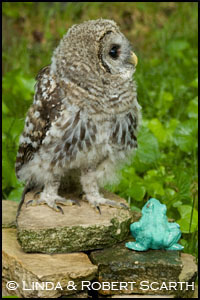introduction - galleries - technique - catalogue - notes - links - contact - blog - deep nature

Barred Owl fledgling
When we read research on Barred Owls, we are sorry for researchers who must avoid anecdotal descriptions of owl behavior in their work. Getting to know a neighborhood owl family can reveal glimpses into their behaviors and character that are hard to quantify without risk of criticism as anthropomorphic. In an undated essay in Round River (1953) edited by Luna B. Leopold, Aldo Leopold reminds us that the observations of careful amateur natural historians can be useful and important ecological studies. Recognizing the risks, here are some observations about one raptor species we admire and enjoy.
In spite of making their presence known through their calls and duets around our older, leafy, small city neighborhood, we do not see Barred Owls as often as we would like. We are told that there has been a nesting pair (or successive pairs) in our neighborhood for at least 25 years. There are other areas of town with resident owls. The bulk of literature describes Barred Owls as living in well watered, wooded tracts, away from disturbance rather than in the middle of a small city. The Barred Owl issue (No. 508, 2000) of the Birds of North America, provides an authoritative review of the literature. All issues in this important publication have a fairly standard format. Three sub-topics in the Barred Owl issue: drinking, bathing and play, are devoid of any information, except a note that one researcher observed captive birds bathe.
The three images here are our evidence that there is information to be gathered. Urban Barred Owls will come to bird baths to drink. We have encountered others at the bubbler in the past (including one splashing vigorously) but this fledgling is the first we photographed stomping around in it and coming specifically to drink. Last summer a pair of fledglings learned to fend for themselves in the somewhat protected backyards of our block. They sat on our garden fence to watch us, played in backyard sprinklers, begged their parents who brought in small rodents, practiced 'hooing", stalked hoses, jumped on a small garden frog statue, took naps in the big old trees and played with feathers.
Two recent studies of Barred Owls at the University of North Carolina-Charlotte found that they are doing well in urban settings. One described older urban residential landscapes as being similar to old forests, with large trees, a dense canopy and an open understory with adequate prey species. The big difference is that there are humans and their trappings to which the owls have adapted. The other study reported that urban owls produced more young than rural ones in the study area, in spite of urban dangers. More food and preferred woodland type are probably contributing factors. Some old city residential neighborhoods and parks may be better habitat than the disrupted patches of forests in rural areas in some regions.
This year's pair of fledglings is much more wary and while we hear them occasionally and have seen them one time in a backyard across the street, they have not come to our backyard sprinkler; put out just for them. Crows sometimes alert us to their probable presence in the dense canopy about the area. Their parents are reinforcing their bond while visiting the big trees behind us. We hear their duets and have seen them groom one another. But to our disappointment they have not brought the fledglings in when we are watching. Perhaps next year we will have the opportunity for other ecological observations that could encourage someone to do a formal study
? Linda & Robert Scarth, 2006.
First published in NatureScape News, 1 (8),10, 2006.
